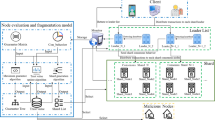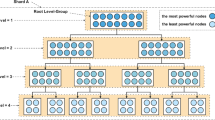Abstract
Existing public blockchain architectures suffer from the difficulty of scaling to support large-scale networks with high TPS, low latency and security. Using the idea of network fragmentation, an improved Raft-based PBFT consensus mechanism is proposed to solve the problem. The network nodes are grouped, and the group adopts the improved Raft mechanism for consensus, and then, the leaders elected in each group form the network committee, and the network committee uses the PBFT mechanism for consensus within the network committee. The results show that R-PBFT is more scalable than PBFT and Raft in a large-scale network environment because it can guarantee high consensus efficiency while having Byzantine fault tolerance; similarly, to improve the fairness between user experience and TPS in blockchain systems, based on the transaction fairness model, a fairness packing algorithm is proposed for storing transactions. It is based on a two-level model, firstly sorting the transactions in descending order based on GasPrice, moreover considering the fairness model for descending order. The experimental confirmed that all the performance of fairness packing is superior to Ethereum packing.
















Similar content being viewed by others
References
Berdik D, Otoum S, Schmidt N et al (2021) A survey on blockchain for information systems management and security. Inf Process Manag 58(1):102397
Li Y, Zheng K, Yan Y et al (2017) EtherQL: a query layer for Blockchain System[M]. In: Candan S, Chen L, Pedersen TB, Chang L, Hua W (eds) Database systems for advanced applications. Springer, Cham
Brewer EA (2000) Towards robust distributed systems. In: Proceedings of the nineteenth annual ACM symposium on principles of distributed computing. ACM Press, New York, 343502. https://doi.org/10.1145/343477
Wang WB, Dinh TH, Xiong ZH et al. (2018) A survey on consensus mechanisms and mining management in blockchain networks. ar-Xiv Preprint, arXiv:1805.02707
Jain RK, Chiu DMW, Hawe WR (1984) A quantitative measure of fairness and discrimination. Eastern Research Laboratory, Digital Equipment Corporation, Hudson, MA
Yuan Y, Wang FY (2016) Blockchain: the state of the art and future trends. Acta Autom Sin 42(4):481–494
Nakamoto S (2019) Bitcoin: a peer-to-peer electronic cash System. consulted
Wood G (2014) Ethereum: a secure decentralised generalised transaction ledger. Ethereum Proj yellow Pap 2014 (151):1–32
Dinh TTA, Wang J, Chen G, Liu R, Ooi BC, Tan KL (2017) Blockbench: a framework for analyzing private blockchains. In: Proceedings of the 2017 ACM international conference on management of data, pp 1085-1100
Kotewicz M (2021) Parity [EB/OL]. https://github.com/openethereum/parity-ethereum. Accessed 29 Mar
Thakkar P, Nathan S, Viswanathan B (2018) Performance benchmarking and optimizing hyperledger fabric blockchain platform. In: IEEE 26th international symposium on modeling, analysis, and simulation of computer and telecommunication systems (MASCOTS). IEEE 8: 264–276
Gorenflo C, Lee S, Golab L, Keshav S (2020) Fastfabric: scaling hyperledger fabric to 20 000 trans- actions per second. Int J Netw Manag 30(5):e2099
Pongnumkul S, Siripanpornchana C, Thajchayapong S (2017) Performance analysis of private blockchain platforms in varying workloads. In: 26th International conference on computer communication and networks (ICCCN). IEEE, pp 1–6
Rouhani S, Deters R (2017) Performance analysis of ethereum transactions in private blockchain. In: 8th IEEE international conference on software engineering and service science (ICSESS). IEEE, pp 70–74
Li C, Bai J, Yi C et al (2020) Resource and replica management strategy for optimizing financial cost and user experience in edge cloud computing system. Inf Sci 516:33–55
Li C, Song M, Zhang M, Luo Y (2020) Effective replica management for improving reliability and availability in edge-cloud computing environment. J Parallel Distrib Comput 143:107–128
Ampel B, Patton M, Chen H (2019) Performance modeling of hyperledger sawtooth blockchain. In: IEEE international conference on intelligence and security informatics (ISI). IEEE, pp 59–61
Hao Y, Li Y, Dong X, Fang L, Chen P (2018) Performance analysis of consensus algorithm in private blockchain. In: IEEE intelligent vehicles symposium (IV). IEEE, pp 280–285
Suankaewmanee K, Hoang DT, Niyato D, Sawadsitang S, Wang P, Han Z (2018) Performance analysis and application of mobile blockchain. In: International conference on computing, networking and communications (ICNC). IEEE, pp 642–646
Chen S, Zhang J, Shi R, Yan J, Ke Q (2018) A comparative testing on performance of blockchain and relational database: Foundation for applying smart technology into current business systems. In: International conference on distributed, ambient, and pervasive interactions. Springer, pp 21–34
Baliga A, Subhod I, Kamat P, Chatterjee S (2018) Performance evaluation of the quorum blockchain platform. arXiv preprint arXiv:1809.03421
Huang D, Ma X, Zhang S (2019) Performance analysis of the raft consensus algorithm for private blockchains. IEEE Transact Syst Man Cybern Syst 50(1):172–181
Gervais A, Karame GO, Wüst K, Glykantzis V, Ritzdorf H, Capkun S (2016) On the security and performance of proof of work blockchains. In: Proceedings of the 2016 ACM SIGSAC conference on computer and communications security, pp 3-16
van Moorsel A (2019) Benchmarks and models for blockchain: consensus algorithms. ACM SIGMETRICS Perform Eval Rev 46(3):113–113
Qashlan A, Nanda P, He X (2020) Automated ethereum smart contract for block chain based smart home security. In: smart systems and IoT: innovations in computing. Springer, Singapore, pp 313–326
Li C, Zhang Y, Zhiqiang H et al (2020) An effective scheduling strategy based on hypergraph partition in geographically distributed datacenters. Computer Netw 170:107096
Li C, Tang J, Ma T, Yang X, Luo Y (2020) A workflow job scheduling algorithm based on load balancing in distributed cloud. J Netw Comput Appl 152:102518
Cha SC, Peng WC, Huang ZJ et al (2017) On design and implementation a smart contract-based investigation report management framework for smartphone applications. In: International conference on intelligent information hiding and multimedia signal processing, Springer, Cham, pp 282–289
Knecht M, Stiller B (2017) Smartdemap: A smart contract deployment and management platform. In: IFIP international conference on autonomous infrastructure, management and security. Springer, Cham 159–164
Li A, Wei X, He Z (2020) Robust proof of stake: a new consensus protocol for sustainable blockchain systems. Sustainability 12:2824
Karakostas D, Kiayias A (2021) Securing proof-of-work ledgers via checkpointing. In: IEEE international conference on blockchain and cryptocurrency (ICBC), pp 1-5. https://doi.org/10.1109/ICBC51069.2021.9461066
Howard H, Mortier R (2020) Paxos vs Raft: Have we reached consensus on distributed consensus?. In: Proceedings of the 7th workshop on principles and practice of consistency for distributed data, pp 1–9
Castro M, Liskov B (1999) Practical byzantine fault tolerance. In: Proceedings of the third symposium on operating systems design and implementation. ACM Press, New York, pp 173–186
Lamport L (1998) The part-time parliament. ACM Trans Comput Syst 16(2):133–169
Ongaro D, Ousterhou TJ (2014) In search of an understandable consensus algorithm. In: Proceedings of USENIX ATC’14: 2014 USENIX annual technical conference. USENIX association, Berkeley, pp 305–320
Eyal I, Gencer AE, Sirer EG et al (2016) Bitcoin-ng: A scalable blockchain protocol. In: 13th {USENIX} symposium on networked systems design and implementation ({NSDI} 16), pp 45–59
Kogias EK, Jovanovic P, Gailly N, et al. (2016) Enhancing bitcoin security and performance with strong consistency via collective signing. In: 25th {usenix} security symposium ({usenix} security 16), pp 279–296
Eyal I, Birman K, Van Renesse R (2015) Cache serializability: reducing inconsistency in edge transactions. In: 2015 IEEE 35th international conference on distributed computing systems. IEEE, pp 686–695
Buterin V (2014) A next-generation smart con-tract and decentralized application platform. Etherum 1:1–36
Larimer D (2014) Delegated proof of stake consensus[R]. [2020–08–19]
Xu X, Sun G, Luo L et al (2021) Latency performance modeling and analysis for hyperledger fabric blockchain network. Inf Process Manag 58(1):102436
Castro M, Liskov B (1999) Practical Byzantine fault tolerance. In: Proc Symp Oper Syst Design Implement, New Orleans, LA, USA, pp 173–186
Lamport L (1998) The part-time parliament. ACM Trans Comput Syst 16(2):133–169
Moraru I, Andersen DG, Kaminsky M (2013) There is more consensus in egalitarian parliaments. In: Proc ACM Symp Oper Syst Principles (SOSP), Farmington, PA, USA 358–372
Reyna A et al (2018) On blockchain and its integration with IoT. Challenges and opportunities. Future Gener Comput Syst 88:173–190
Liang W et al (2020) An industrial network intrusion detection algorithm based on multi-feature data clustering optimization model. IEEE Trans Ind Informat 16(3):2063–2071. https://doi.org/10.1109/TII.2019.2946791
Rizun PR (2015) A transaction fee market exists without a block size limit. Block size limit debate working paper
Li C, Song M, Yu C, Luo Y (2021) Mobility and marginal gain based content caching and placement for cooperative edge-cloud computing. Inf Sci 548:153–176
Möser M, Böhme R (2015) Trends, tips, tolls: a longitudinal study of Bitcoin transaction fees. In: International conference on financial cryptography and data security. Springer, Berlin, Heidelberg, pp 19–33
Acknowledgements
The work was supported by the National Natural Science Foundation (NSF) under grants (No. 61873341, 62171330), Key Research and Development Plan of Hubei Province (No. 2020BAB102), Open project of CAAC Key Laboratory of Civil Aviation Wide Surveillance and Safety Operation Management & Control Technology (No.202001), Open Research Fund Program of Data Recovery Key Laboratory of Sichuan Province (Grant No. DRX2001). Any opinions, findings and conclusions are those of the authors and do not necessarily reflect the views of the above agencies.
Author information
Authors and Affiliations
Corresponding author
Additional information
Publisher's Note
Springer Nature remains neutral with regard to jurisdictional claims in published maps and institutional affiliations.
Rights and permissions
About this article
Cite this article
Li, C., Zhang, J. & Yang, X. Scalable blockchain storage mechanism based on two-layer structure and improved distributed consensus. J Supercomput 78, 4850–4881 (2022). https://doi.org/10.1007/s11227-021-04061-3
Accepted:
Published:
Issue Date:
DOI: https://doi.org/10.1007/s11227-021-04061-3




